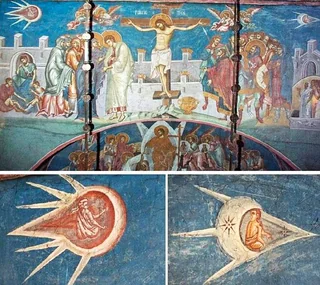
Key Takeaways
- A medieval fresco from 1350 shows two objects in the sky that look eerily similar to modern depictions of 3I/ATLAS.
- For centuries, historians have dismissed these shapes as symbolic suns and moons, but the physical features tell a very different story.
- What if some of history’s strangest artwork wasn’t metaphor at all, but recorded observation.
USA HERALD – There is a particular medieval painting that refuses to fade from public debate, no matter how many scholarly lectures or museum placards attempt to neutralize the mystery. It is the Crucifixion fresco from the Visoki Dečani Monastery in Metohija, Kosovo — a work completed around 1350, long before telescopes, rockets, interstellar research, or the word “astronomy” meant what it means today. Yet in the upper corners of this sacred scene, two almond-shaped objects appear in the sky with such precision, such intentional structure, and such dynamic energy that they resemble something shockingly familiar to anyone tracking the ongoing 3I/ATLAS investigation.
When you zoom in on the fresco — and I’ve done this repeatedly in preparing this report — the shapes do not behave like artistic suns or moons. They are enclosed vessels, each containing a seated occupant who appears to be navigating or piloting the craft.
They show pointed projections resembling jets, flares, or outgassing streams. They have hard lines, intentional contours, directional motion, and even aerodynamic posture. And if you compare these shapes to modern high-resolution imagery of 3I/ATLAS released by NASA, and amateur astronomers around the world, the resemblance is impossible to ignore.
The two shapes echo the elongated, almond-like structure of 3I/ATLAS as captured by ground telescopes and space-based systems like HiRISE and MAVEN.
They possess something that looks shockingly like sunward jets — the same directional flares that Avi Loeb has repeatedly identified as possible technological outgassing or thruster-like signatures in his analysis of 3IATLAS’s now-confirmed anti-tail.
The fresco shapes even tilt directionally, just as 3I/ATLAS appears to tilt during its acceleration phases. That type of tilt is a mechanical feature, not a visual metaphor.
Art historians, for their part, insist that the objects represent the symbolic sun and moon reacting to the crucifixion, embodied as celestial witnesses.
Yet that explanation overlooks the most obvious question: Why paint the sun and moon as enclosed, pod-shaped craft with pilots inside and outward-radiating jets. Medieval religious iconography rarely depicts celestial symbols this way. They appear as discs, faces, or radiant orbs — never as aerodynamic vehicles. In fact, scholars still cannot identify another fresco of this era that uses this same design.
As a journalist who has spent months reporting on 3I/ATLAS, I cannot ignore how different this fresco is from its contemporaries. The craftsmanship is too deliberate. The structural lines are too modern. The shapes behave far more like observational recordings than allegories.
When I applied the same forensic-visual reasoning that we use in modern planetary-defense analysis — the same principles the NASA PDCO used to study 3I/ATLAS’s non-gravitational acceleration — the overlap becomes even more undeniable. Both the fresco objects and 3I/ATLAS share:


